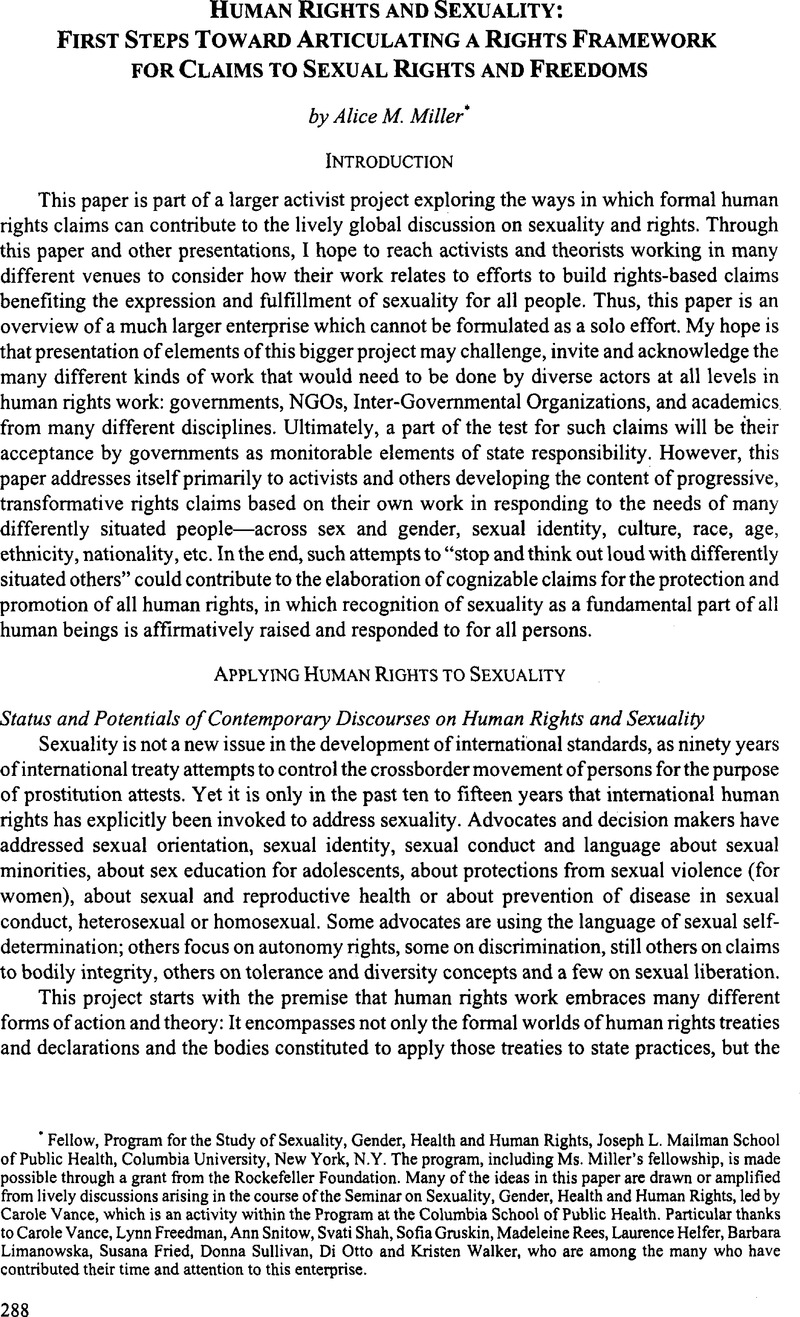Published online by Cambridge University Press: 28 February 2017

1 See Dudgeon v. United Kingdom, 4 Eur. Ct. H.R. 149 (1981); Noms v. Ireland, 13 Eur. Ct. H.R. 186 (1991); Modinos v. Cyprus, 16 Eur. Ct. H.R. 186 (1993), Rees v. United Kingdom A106 (1986); Cossey v. United Kingdom, A 184 (1990); B. v. France (1992), Sheffield v. United Kingdom Eur. Com. H.R. (1998); P v. S and Cornwall, 1996 IRLR 347, C-13/94 [1996] ICR 795; Grant v. SW Trains, 1998 IRLR 188, All ER EC 1998-C-249/96; Kerkhoven v. Netherlands (1992), X, Y and Z v. United Kingdom, Eur. Ct. H.R. (1997).
2 Report of the Special Rapporteur on Violence against Women, its causes and consequences, A Policies and practices that impact women’s reproductive rights and contribute to, cause or constitute violence against women, UN Doc. E/CN.4/1999/68/Add, 4 (21 January 1999); Report of the Special Rapportuer on Extrajudicial, Summary or Arbitrary Executions, UN Doc. E/CN.4/1999/39 (6 Jan. 1999); Opinions adopted by the Working Group on Arbitrary Detention, UN Doc. E/CN.4/1999/63/Add.1
3 Michael Foucault, The History of Sexuality (1978).
4 I am particularly indebted to the work of Di Otto in her consideration of the impact of these tools on human rights, in her articles Everything is Dangerous: Some Post-Structural Tools for Rethinking the Universal Knowledge Claims of Human Rights Law, 5 Australian J. of Hum. RTs. 17 (1998); Rethinking Universals: Opening Transformative Possibilities in International Human Rights Law 18 Australian Y.B. of Int’l L. 1-36 (1997); and Rethinking the Universality of Human Rights Law 29 Colum. Hum. Rts. L. Rev. 1 (1997). Otto uses the definition of post-structuralism derived from Carol Smart, as indicating “interest in the local mechanisms of power, how concrete bodies are invested with particular meanings and subjectivities, and how these effects of power can be resisted.” Otto at n.4 in Everything is Dangerous.
5 One of the most succinct reviews of developments and concerns around new rights claims in the Un, coupled with formulations of standards for such claims is found in Alston’s, Philip Conjuring Up New Human Rights: A Proposal for Quality Control, 78 AJIL 607 (1994)CrossRefGoogle Scholar.
6 See, for example, Heinze’s, Eric Model Declaration of Rights against Discrimination on the Basis of Sexual Orientation, in Sexual Orientation: A Human Right 291 (Heinzeed, E.., 1995)Google Scholar.
7 Correa, Sonia & Rosalind, Petchesky, Reproductive and Sexual Rights: A Feminist Perspective, in Population Policies Reconsidered: Health, Empowerment and Rights 114, at 107-23 (Sen, Gita, Germain, Adrienne, and Chen, L.C., eds., 1994)Google Scholar.
8 Vance, Carole, Pleasure and Danger: Toward a Politics of Sexuality, in Pleasure and Danger: Exploring Female Sexuality 5, at 1-27 (Vance, Carole S. ed., 1984)Google Scholar.
9 See, for example, the early challenge set by Gayle Rubin in Thinking Sex: Notes for a Radical Theory of the Politics of Sexuality, in Pleasure and Danger: Exploring Female Sexuality, supra note 6, at 267-319.
10 For a discussion of three different models of tolerance (negative, pluralist or emancipatory) see Morgan, Wayne & Walker, Kristen, Tolerance and Homosex: A Policy of Control and Containment, 20 Melb. U.L. Rev. 202 (1995)Google Scholar.
11 Within the framework of women’s human rights, Ros Petchesky has been developing formulations of sexual rights that introduce concepts of pleasure, for example. In part as a response to the limited success of the violations/sexual violence model, activists and theorists have begun developing formulations of “sexual rights” that introduce concepts of pleasure and the need for conditions that empower diverse choices. See, e.g., Petchesky, Rosalind, Sexual Rights: Inventing a Concept, Mapping an International Practice, in Reconceiving Sexuality (Parker, Richard G. & Barbosa, Regina eds., forthcoming)Google Scholar or alternatively, Paper presented at the Conference on Reconceiving Sexuality, Rio de Janeiro, April 14-18,1996. (on file); Abeyesekera, Sunila, Adivism for Sexual and Reproductive Rights, in 2 Health and Human Rights 39 (1997)CrossRefGoogle Scholar.
12 Rebecca Cook has been active in promoting this work. For an example of an application of her principles to sexual and reproductive rights, see Toward a More Effective Implementation of Women’S Right to Health, With a Focus on Reproductive and Sexual Rights, background prepared by Rhonda Copelon, Sofia Gruskin and Nahid Toubia for the Roundtable of Human Rights Treaty Bodies Human Rights Approaches to Women’s Health, Dec. 8-11, 1996, UNDAW/UNFPA/UNHCR (paper on file with author); The Roundtable took place in Glen Cove, N.Y. See also Correa and Petchesky at note 7, above for another example of thematic groups, what the authors call “four component principles” that make up the ethical bases for sexual and reproductive rights. Their list includes: bodily integrity, personhood, equality and respect for diversity. See Correa & Petchesky, supra note 7, at 107-08
13 Richards, David A. J., Sexual Preference as a Suspect (Religious) Classification: An Alternative Perspective on the Un Constitituionality of Anti-Lesbian/Gay initiatives, 55 Ohio St. L.J. 491 (1994)Google Scholar.
14 See Miller, Alice M. et al., Health, Human Rights and Lesbian Existence, in Health and Human Rights: A Reader 265 (Mann, Jonathon et al. eds., 1999)Google Scholar.
15 A number of activists and authors have begun to look at the potentials for organizing coalitions arising out of a focus on claims of “sexual rights.” See, for example Parker, Richard G., Sexual Rights: Concepts and Action in 2 Health and Human Rights 31 (1997)CrossRefGoogle ScholarPubMed; Fried, Susana and Landsberg-Lewis, Liana, Sexual Rights: Emergence of the Term (in forthcoming Women’s International Human Rights, Askin, Kelly Dawn ed.Google Scholar) (paper on file with author).
16 See Abdallahi An-Na’im, Towarda Cross-Cultural Approach to Defining International Standards of Human Rights: The Meaning of Cruel, Inhuman or Degrading Treatment or Punishment in Human Rights in Cross-Cultural Perspective: A Quest for Consensus 19, at 19-43 (Abdallah! An-Na’im ed., 1992).